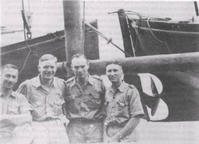


War History of the Australian Meteorological Service
Foreword
Preface
Introduction
Chapter 1: D.Met.S.—Australia's Wartime Weather Service
Chapter 2: The Weather Factor in Warfare
Chapter 3: Met in the Retreat
The Evacuations from Ambon and Namlea
Fall of Salamaua
The Singapore Expedition/ Brief Visit to Singapore
Trek across Timor/ The Retreat in Timor
Sea Escape from Tulagi
Vila and Noumea Bases
The Attacks on Darwin and Broome
Chapter 4: Met in the Advance
Chapter 5: Meteorology in Aviation
Chapter 6: Central Forecasting Services
Chapter 7: Met With the Army
Chapter 8: Research and Personnel Training
Chapter 9: Instrumental Development and Maintenance
Chapter 10: Scientific Developments in the RAAF Meteorological Service
Chapter 11: Divisional Bureaux and Their Work
Appendix 1: List of Reports Provided by D.Met.S. for Advances Operational Planning and Other Purposes
Appendix 2: List of Service Personnel RAAF Meteorological Service
Appendix 3: List of Civilian Personnel Who Worked Together with Service Personnel of the RAAF Meteorological Service
Appendix 4: List of Locations at which RAAF Meteorological Service Personnel Served
Index
Search
Help
Contact us

The Singapore Expedition/ Brief Visit to Singapore
Meanwhile, back in Singapore, where the Australian party arrived on 7 January 1942, things had become so hot that it was impossible for the men to go to their various points on posting. For a time they were attached to the Royal Air Force meteorological section in Sime Road, but when it was decided to withdraw the bomber squadrons, the Australian weather men were instructed to accompany them to Palembang, in Sumatra, to provide a service from the new base.They left by sea convoy on 27 January 1942, reaching Pladjoe on the Moesi River two days later after only one ineffectual high level attack by the Japanese. From there the road lay onwards by motor truck and train to Palembang II aerodrome, about 40 miles outside the town, where the Australians were soon keeping a 24-hour watch at SHQ to brief bombing missions on Malaya, Indo-China and, later, Singapore itself. It was a difficult task, due to the paucity of reports from the territory concerned and the fact that in-flight weather reports from machines actually in the air had not yet been introduced, but the weather men were fortunate that the enemy paid no attention to the number two aerodrome during their stay, although Palembang I was raided several times, culminating in an attempted paratroop landing there on 14 February.
At this stage all personnel of the number two aerodrome were ordered to evacuate to Lahat, about 100 miles to the south-west towards the mountains. All equipment, including personal belongings, was burned and the party set off, only to be recalled when 10 kilometres along the road as news came through that the Dutch troops had beaten off the enemy attack.
It was only a brief respite, though, because by the following day the Japanese had penetrated up the Moesi River to Palembang, bringing the town and satellite aerodrome under attack from ground and air forces. Again the order was given, with the rendezvous changed from Lahat to Oosthaven—a port at the southern end of Sumatra. Officers were placed in charge of groups of men, with instructions to get them as quickly as possible to Oosthaven, and by one means or another all the weather personnel had arrived by the following day. About noon they went aboard ship for Merak, in north-west Java, thence the trip to Batavia was completed by train, arriving on 17 February.
Instructions and counter-instructions about joining the RAF weather section, which had come from Singapore to Soekaboemi, climaxed in the decision to send the Australians home. They left a week later on the Deucalion, with 400 personnel of the RAF, RNZAF and RAAF and by 2 March 1942 were in Fremantle.

 |
Bureau of Meteorology |  |
© Online Edition Australian Science and Technology Heritage Centre and Bureau of Meteorology 2001
Published by Australian Science and Technology Heritage Centre, using the Web Academic Resource Publisher
http://www.austehc.unimelb.edu.au/fam/0648.html